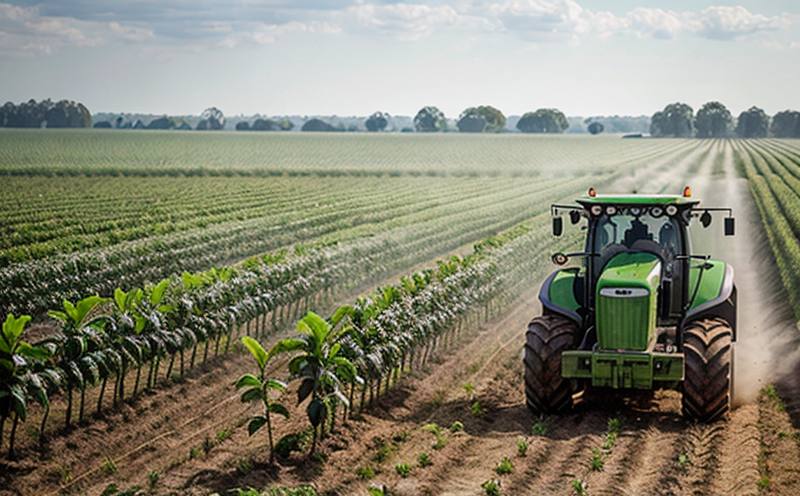EN 16260 Soil Quality Agricultural Pesticide Residue Testing
The EN 16260 standard provides a robust framework for assessing agricultural pesticide residues in soil, ensuring that food safety and environmental sustainability are upheld. This test is crucial for quality managers, compliance officers, R&D engineers, and procurement teams who must ensure that agricultural inputs do not lead to harmful residue levels in the final produce or the environment.
The EN 16260 standard is designed to measure pesticide residues in soil samples, focusing on both synthetic pesticides and natural compounds used as alternatives. This method ensures compliance with international standards such as ISO and European Directives. The testing protocol covers a wide array of parameters, including but not limited to:
- Residues from commonly used agricultural chemicals.
- Natural pesticides derived from plants or microorganisms.
- Synthetic pesticides that are known for their persistence in soil.
The standard mandates the use of specific extraction methods and analytical techniques to ensure accurate measurement. The testing process involves several critical steps:
- Sample Collection: Soil samples are collected from representative locations, ensuring a mix of different types of soil if necessary.
- Precipitation and Extraction: Samples undergo a series of extraction processes to release pesticides into a solvent for analysis.
- Analytical Determination: The extracted residues are analyzed using high-performance liquid chromatography (HPLC) or gas chromatography-mass spectrometry (GC-MS).
- Quantification and Reporting: Results are quantified against established limits, and the data is reported in line with EN 16260.
The standard provides detailed acceptance criteria for pesticide residues, ensuring that only soil samples meeting these criteria can be used for agricultural purposes. This ensures not only food safety but also environmental sustainability by minimizing harmful impacts on ecosystems.
| Sample Type | Pesticide Classes Tested | Extraction Method | Analytical Technique |
|---|---|---|---|
| Agricultural Soil | Synthetic and Natural Pesticides | Precipitation and Solvent Extraction | HPLC/GC-MS |
| Urban Garden Soil | Common Residues Only | Solvent Extraction | Gas Chromatography |
| Pesticide Class | Agricultural Use Limit (mg/kg) | Environmental Safety Margin (EVM) | Data Reporting Format |
|---|---|---|---|
| Synthetic Pesticides | 10-50 mg/kg depending on pesticide type | EVM ≥ 20x recommended dose | Excel Spreadsheet and PDF Report |
| Natural Alternatives | 5-30 mg/kg based on botanical source | EVM ≥ 15x recommended dose | Data Visualization Dashboard |
This testing ensures that agricultural practices are sustainable and in line with international standards. It also helps in identifying potential risks early, allowing for corrective measures to be implemented promptly.
Why Choose This Test
The EN 16260 Soil Quality Agricultural Pesticide Residue Testing is essential for several reasons:
- Compliance with International Standards: Ensures adherence to ISO and European Directives.
- Safety Assurance: Guarantees that agricultural products are free from harmful residues, protecting both consumers and the environment.
- Risk Management: Identifies potential risks early, allowing for corrective measures in a timely manner.
- Environmental Sustainability: Minimizes adverse impacts on ecosystems by ensuring safe pesticide use practices.
The test is particularly beneficial for quality managers and compliance officers who need to ensure regulatory adherence. R&D engineers can rely on this testing to innovate safer agricultural chemicals, while procurement teams benefit from the assurance of reliable data.
By choosing EN 16260 soil testing, you are investing in a sustainable future where both human health and environmental balance are prioritized.
Environmental and Sustainability Contributions
The implementation of EN 16260 has significant contributions to environmental sustainability:
- Reduction in Pesticide Use: By identifying residues, the standard encourages reduced pesticide use.
- Mitigation of Soil Contamination: Ensures that only soil free from harmful residues is used for agricultural purposes.
- Enhanced Crop Quality: Safe pesticides lead to higher quality and safer crops.
- Biodiversity Preservation: By minimizing contamination, the environment remains rich in biodiversity.
The standard's focus on both synthetic and natural pesticides ensures a balanced approach that considers all aspects of agricultural chemical use. This holistic view is crucial for achieving long-term sustainability goals.
Use Cases and Application Examples
- Agricultural Research: Researchers can test new pesticide formulations to ensure they meet safety standards before commercial release.
- Farm Management: Farmers can use the results to adjust their pesticide application practices, ensuring compliance with regulations while maintaining soil quality.
- Regulatory Compliance: Government bodies and international organizations rely on this test to enforce agricultural chemical regulations worldwide.
- Consumer Safety: Testing ensures that food products are safe for consumption, reducing the risk of pesticide-related health issues.
| Use Case | Application Example | Main Outcome |
|---|---|---|
| Agricultural Research | Testing new biodegradable pesticides | Identifying safe and effective alternatives to synthetic pesticides. |
| Farm Management | Adjusting pesticide application rates | Ensuring compliance with local regulations while maximizing crop yield. |
| Regulatory Compliance | Monitoring soil quality in different regions | Creating a database of soil safety across diverse agricultural landscapes. |
| Consumer Safety | Testing imported food products for pesticide residues | Ensuring that international trade does not compromise local health standards. |
In conclusion, the EN 16260 standard plays a pivotal role in maintaining soil quality and ensuring safe agricultural practices. It is a cornerstone in achieving sustainable agriculture, safeguarding both human health and environmental integrity.





